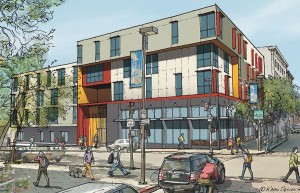 California’s housing shortage has been well documented. But the obvious solutions to the problem — like eliminating local land use restrictions on new growth — have been stymied in part by infighting among the housing advocate community.
California’s housing shortage has been well documented. But the obvious solutions to the problem — like eliminating local land use restrictions on new growth — have been stymied in part by infighting among the housing advocate community.
The split involves affordable housing advocates and those who want more market-rate development. Here’s the basic summary of their positions, as I see them:
- Market-rate housing advocates typically want barriers to all new housing removed as quickly as possible. They usually support policies to subsidize affordable housing for low-income residents but mainly want to see housing of all types built as fast and cheaply as possible.
- Affordable housing advocates want more subsidies for affordable housing and more affordable units required of market-rate projects. In that aspect, they often align with market-rate developer advocates. But they are also protective of low-income neighborhoods from gentrification, which they primarily blame on new market-rate developments in these neighborhoods, and so will often oppose market-rate projects in low-income areas. They also use existing land use restrictions on market-rate development as leverage to extract more affordable housing units or dollars. As a result, many of these advocates tend to want to keep the status quo (at least for market-rate development restrictions) and limit new development to prevent gentrification.
This split was perhaps most prominent back in 2011, when a bill to reduce excessive local parking requirements statewide on new housing near transit was opposed by affordable housing advocates. Why? Many of these advocates use high parking requirements as leverage to extract more affordable units. Using the state’s “density bonus” law, they can trade reductions in parking requirements for more affordable units.
The split also appears when it comes to raising dollars for affordable housing production. Affordable advocates will attempt to extract the most fees and affordable units they can from market-rate development, which in turn makes market-rate development harder to build.
But there’s a solution to this problem that leaders on both side could support: a separately funded, statewide source of permanent dollars for affordable housing. A separate source of funding would go a long way to eliminating the incentive for affordables to oppose or weaken market-rate development.
Such a plan has been proposed in the legislature, such as SB 2 (Atkins), which would impose a $75 fee on recorded real estate documents to fund affordable housing. But its future is murky, absent more broad-based support.
To be sure, such a fund wouldn’t solve the concerns that affordable housing advocates have about gentrification caused by specific market-rate projects, and it may not reduce their resistance to alleviating local land use restrictions when those restrictions could lead to more affordable units. But at least they would no longer have an incentive to extract higher fees from market-rate development, and a bigger pot of money for affordable units across the board may reduce their desperation to claw every bit they can from new projects.
In the long run, California will not be able to subsidize its way out of the affordable housing crisis. It would require billions of dollars we don’t have. And in fact, most low-income residents don’t live in subsidized housing but rather in the market-rate housing of yesteryear, which has now come down in price with age. So the more we fail to build market-rate housing today, the more we limit affordable units for future generations.
It’s not an easy fight to solve, but a permanent source of dollars for affordable units is not only the right thing to do on its own merits, it could ease our housing debates going forward.


